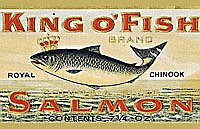The Old and the New
The photograph titled “Celilo Whirlpool” depicts two Native fishers using dipnets in front of a commercial fishwheel. Compared to traditional fishing methods, fishwheels were the epitome of modern efficiency. Dipnets, for example, required a significant amount of human labor to operate, and individuals could only harvest a small percentage of a given fish run. A fishwheel never tires, requires little human labor, and extracts salmon from the rapids without ceasing for an entire season. Fishwheels were so efficient that Oregon outlawed them in 1926 to protect the fishery; Washington followed suit in 1934. In the modern period, fisheries managers have used voter initiatives and state and federal regulations to control the use of the resource and to quell conflict between users. But conflict over and regulation of the fisheries is not new. Long before contact with whites, Native people regulated their use of natural resources both on and off reservation lands.
After what must have been much trial and error, Indians developed social and political structures that allowed them to successfully regulate their fishery. Native fishers gained access to specific fishing sites on the Columbia River through tribal or band affiliation, inheritance, or relationships such as marriage—a practice that limited access to the resource. Moreover, community leaders determined when fish could be harvested. Edicts such as those that prevented night fishing allowed "escapement," so that a portion of a run could continue upstream. Ceremonial practices instilled harvest limits by determining when the fishing could begin and end. In 1977, the Yakama, Warm Springs, Umatilla, and Nez Perce tribes formed the Columbia River Inter-Tribal Fish Commission to advocate for and provide technical assistance to treaty fishers. Over time, fishing gear changed dramatically with improved technology, but the need to control seasonal fish harvests did not.
Indians developed sophisticated technology to harvest salmon from the Columbia River and its tributaries, technology that was adapted to the environment in which it was used. In areas of slack water, Native fishers used canoes and nets to gather fish; but in rapids, they used dipnets and spears and fished from long wooden scaffolds that extended out over the water. Indians also altered the river environment to make fishing easier: they built stone walls or fences near riverbanks to slow the current down and provide salmon with a place to rest on their journey upstream. Indians could then spear or poison them as they rested, ensnared in the human-made trap.
With contact and the rise in the availability of new materials, the supplies Indians used to construct their fishing gear changed. Steel hooks replaced those of Indian manufacture, cotton and then nylon replaced nets made from hemp or nettle fiber, commercially-milled lumber replaced wood collected for scaffolds. The impact of new products on Indian communities is visible in the photograph “Chinook Indians Seining,” which depicts commercial nets and floats and contemporary clothing. Yet the harvesting of fish from the Columbia River’s mouth with seine nets was a traditional activity. Similarly, when Jimmy George and Charley Quittoken, shown in the related document titled “Fishing Nets,” mended nylon dipnets to be used at Celilo Falls, they too were tied to traditional work. The reed mat behind them, their modern clothes, traditional hairstyles, and Mr. Quittoken’s wheelchair represent the mix of modern and traditional materials and habits that Indians throughout the Pacific Northwest adopted in their changing world.
Many images of the Native fishery portray the labor of men, but the work of women was crucial to the success of salmon harvesting. Traditionally, men caught salmon, and women collected and processed them, cleaning and butchering the fish and hanging them to dry or smoking them. It was skilled work that was often difficult and demanding. It was also work that had to be done quickly so that the salmon would not rot. Women worked until the last fish had been prepared for drying, regardless of how many hours that took, and then tended the salmon until they could be stored.
Work on the river was divided by gender, but it was also complimentary. Native communities valued and even celebrated women’s work because it ensured that salmon would be available throughout the year. Threats to fishing rights obviously endangered Native men’s work, but they also placed in jeopardy the ways in which women contributed to their families. Today, Indian women are more likely to fish than their great-grandmothers were, although photographic evidence would suggest that entire families participated directly in fishing in earlier times.
© Katrine Barber, 2006. Updated and revised by OHP staff, 2014.





